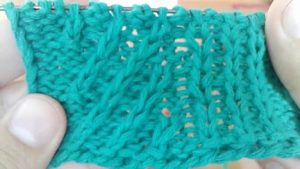
An elastic knitting element is called an elastic band. There are several options for creating elastic bands that are actively used by needlewomen. It is necessary to choose a suitable element taking into account what kind of clothes you plan to knit. Diagonal elastic is very common, which looks like braids. It can be used to decorate any knitted product.
Process of creation
To knit a diagonal elastic band, you need:
- Cast on loops on the knitting needles, the number of which will be a multiple of 4. Add 2 more edge loops to the resulting value.
- In total, 4 main rows are needed to create a diagonal elastic band. The number of these rows depends on how wide the elastic is planned.
- First row: 2 knit stitches, 2 purl stitches.
- Second: 1 knit stitch, 2 purl stitches and 1 knit stitch.
- Third: purl 2, knit 2;
- Fourth: 1 purl, 2 knit and 1 purl.
Then the pattern is created by repeating the sequence from the 1st to the 4th row.
Types of elastic bands and their knitting patterns

In addition to diagonal elastic, needlewomen can use other options for decorating a knitted product.
Simple elastic band
This is a classic type of elastic band, which is the main one for other options. To create a pattern, you will need to alternately sculpt 1 front and 1 purl loops. This method is simple, so even inexperienced people can do it.
Patent
This knitting technique can be used to create any clothing: sweater, hat, cardigan, scarf. Every needlewoman should master a patent elastic band, as this is the basis. The main difference from the previous one is the odd number of loops.
Technique:
- The first stitch is a knit stitch, then yarn over, slip 1 stitch and do not knit it, knit 1 again.
- When creating subsequent rows, yarn over before each purl stitch. The purl stitch is removed, and a double crochet loop is knitted behind the front wall.
False
The resulting elastic band is similar in appearance to an element made according to the English scheme. Only the false elastic band is created in a completely different way. In addition, the yarn consumption here is minimal, and the elastic is dense and elastic. The false elastic band is made very simply: knit 3, purl 1, knit 2, purl 1 and knit 1.
Polish
This technique is used when knitting children's clothes. The reason is that the elastic is dense but has a soft texture. The number of loops must be a multiple of 4. To create a Polish rib, you need to alternate rows according to the following pattern: 1 front, 1 back; 1 purl, 2 knit and 2 purl. The row ends with 1 knit stitch.
French
This elastic band is used as a decorative element, for example, when knitting an openwork product. This technique allows you to transform any clothing, making it more elegant. The pattern is created according to the following scheme:
- First row: regular 2x2 rib.
- Second row: purl 1, knit 2 and purl 1.
Italian
This is another decorative element that decorates cardigans, jumpers and other clothes that require a voluminous finish. Execution scheme:
- First row: 2 purl and 2 knit stitches.
- Second row: knit 2 and purl 2.
- Third row: similar to the first, only the 2nd and then the 1st loop are knitted first.
- Fourth: similar to the second, only the 2nd loop is knitted first, and then the 1st loop.
- Then create the pattern, starting from the third row.
Diagonal elastic, despite the simplicity of knitting, looks very elegant and original. With its help you can decorate any clothing, making it original. The knitting pattern is simple, so even beginners can create this element very quickly.


 0
0





